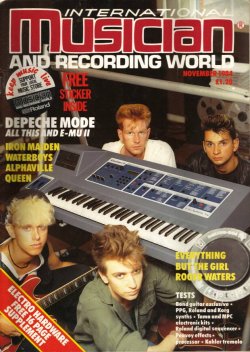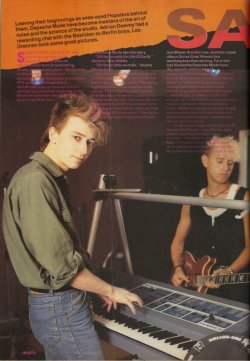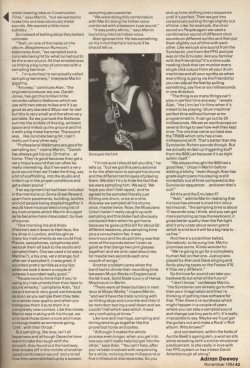Sampling Mode
[International Musician And Recording World, November 1984. Words: Adrian Deevoy. Pictures: Les Drennan.]
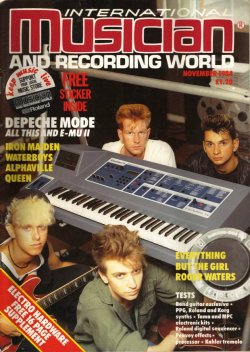
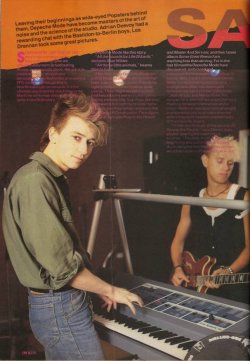

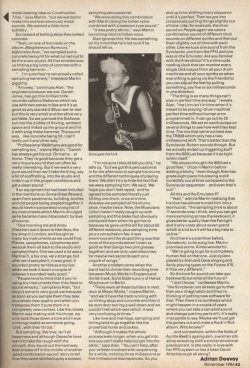
Leaving their beginnings as wide-eyed popsters behind them, Depeche Mode have become masters of the art of noise and the science of the studio. Adrian Deevoy had a rewarding chat with the Basildon-to-Berlin boys, Les Drennan took some great pictures.
Somewhere, off one of the corporate corridors in the labyrinthine complex we affectionately term Broadcasting House, a woman sits alone. Her job is to create emotion, tension and atmosphere. Her key to this process is a PPG system. Although this is heartbreakingly unromantic it is the ultimate argument for machines in the Machine vs Human debate. It’s also quite a nice little story.
Depeche Mode like this story.
“All the sounds for Life Of Earth,” declares Alan Wilder.
“All those little animals,” beams Martin Gore.
After four years Depeche Mode are pretty bogged off with being told that they make inhuman music. They quite rightly believe this accusation to be untrue. They might accept that their first two albums weren’t cataclysmic – catchy, melody blip-bops if you like your lager warm but nothing to telex home about – but they remain adamant that last year’s LP, Construction Time Again, this years singles People Are People and Master And Servant, and their latest album Some Great Reward are anything less than stirring. For in the last 18 months Depeche Mode have discovered, embraced and subsequently immersed themselves in sound. With the aid of producer Daniel Miller’s matchmaking Synclavier a strange love affair has developed between the band and sampled noise.
Alan Wilder and Martin Gore, the songwriters, seemed worst smitten to a meeting between themselves and a micro-Walkman was promptly arranged in a horrendously loud video wine bar where they both bawled unashamedly of their love for sound.
“I’ll take you through all the sounds on People Are People,” says Martin, eyes glazed, sparing the machine no blushes. “The bass drum at the beginning was just an acoustic bass drum sampled into a Synclavier then we added a piece of metal to that – just a sampled anvil type sound – to give it a slight click and make it sound a bit different. That’s the beauty of the Synclavier, you can edit sounds together to make what we call combination sounds. The main synth sound is the actual ‘synth’ sound on the Synclavier, that’s the one that plays the bass riff. But the bass sound is a combination sound too with part of it being an acoustic guitar plucked with a coin, which sounds very interesting when the two sounds are sequenced together.”
“There’s very little playing going on in People,” adds Alan, “virtually everything is sampled into the Synclavier. With the guitar sounds we altered them slightly once they were in the Synclavier because you sample in one note and then you can alter the length and dynamic of every note in the sequence for the guitar part so it will give expression, but it will still be completely in time. You can justify all the rhythms, you see, so that you can have articulation but it’s all in time.”
Getting back to the People Are People breakdown Martin unveils a short sampling anecdote: Love on a plane.
“I took a stereo Walkman when I was going on a plane from England to somewhere,” he begins. “I originally brought it along to take the takeoff but while the air hostess was doing her safety speech at the start of the flight I decided I’d take that as well. But as she was telling everyone to ‘Check the instruction cards under your seat,’ the door flew open and all this air rushed in which made a real noise and everyone laughed. Anyway I looped the end of what she was saying and the laughter so it goes, ‘…tion cards ha ha ha ha …tion cards ha ha ha ha,’ which sounds funny but I used it in conjunction with a choir sound and it added a really nice texture to the bridge on People.”
“There’s a Synclavier harp sound in the verses,” contributes Alan, “and an ARP sequencer playing very fast in the chorus and there’s some Emulator sounds that we used for adding a few frills here and there.”
The three throaty clunks at the end of each chorus is in fact Martin’s throat.
“That was a combination sound,” says Alan. “First of all we sampled Martin going, ‘Unk Unk Unk,’ with his throat then we added a bell sound and a timpani to give it depth.”
“I felt a bit of a berk doing that,” admits Martin. But love’s a bit like that.
The vocal line, “It’s a lot… like life,” at the beginning of Master and Servant was yet more fodder for the Synclavier. As Alan explains.
“Firstly we got a lot of people singing the high, ‘It’s a lot,’ and then a low, ‘Like life.’ You don’t have to play one slower or faster than the other to get the octave either because you make a patch on the Synclavier keyboard for each part and then you play the parts in their natural pitches and both at the same speed which is very handy.”
[International Musician And Recording World, November 1984. Words: Adrian Deevoy. Pictures: Les Drennan.]
An early technical article from when the band first hit a stride with sampling. Alan and Martin discuss in detail how sounds on Some Great Reward were constructed. Plenty of focus on equipment and methods, and aspects such as timing and sequencing. Although some of it will go over the average reader's head, the article is full of anecdotes which keep it interesting.
" “Professional Walkmans are good for sampling too,” claims Martin. “Gareth has always got his out. On trains… at home. They’re good because they get a very impure sound that can often be really interesting. But if we want a very pure sound then we’ll take the thing, say a bit of scaffolding, into the studio and mike it up in the proper conditions and get a clean sound.” "




Leaving their beginnings as wide-eyed popsters behind them, Depeche Mode have become masters of the art of noise and the science of the studio. Adrian Deevoy had a rewarding chat with the Basildon-to-Berlin boys, Les Drennan took some great pictures.
Somewhere, off one of the corporate corridors in the labyrinthine complex we affectionately term Broadcasting House, a woman sits alone. Her job is to create emotion, tension and atmosphere. Her key to this process is a PPG system. Although this is heartbreakingly unromantic it is the ultimate argument for machines in the Machine vs Human debate. It’s also quite a nice little story.
Depeche Mode like this story.
“All the sounds for Life Of Earth,” declares Alan Wilder.
“All those little animals,” beams Martin Gore.
After four years Depeche Mode are pretty bogged off with being told that they make inhuman music. They quite rightly believe this accusation to be untrue. They might accept that their first two albums weren’t cataclysmic – catchy, melody blip-bops if you like your lager warm but nothing to telex home about – but they remain adamant that last year’s LP, Construction Time Again, this years singles People Are People and Master And Servant, and their latest album Some Great Reward are anything less than stirring. For in the last 18 months Depeche Mode have discovered, embraced and subsequently immersed themselves in sound. With the aid of producer Daniel Miller’s matchmaking Synclavier a strange love affair has developed between the band and sampled noise.
Alan Wilder and Martin Gore, the songwriters, seemed worst smitten to a meeting between themselves and a micro-Walkman was promptly arranged in a horrendously loud video wine bar where they both bawled unashamedly of their love for sound.
“I’ll take you through all the sounds on People Are People,” says Martin, eyes glazed, sparing the machine no blushes. “The bass drum at the beginning was just an acoustic bass drum sampled into a Synclavier then we added a piece of metal to that – just a sampled anvil type sound – to give it a slight click and make it sound a bit different. That’s the beauty of the Synclavier, you can edit sounds together to make what we call combination sounds. The main synth sound is the actual ‘synth’ sound on the Synclavier, that’s the one that plays the bass riff. But the bass sound is a combination sound too with part of it being an acoustic guitar plucked with a coin, which sounds very interesting when the two sounds are sequenced together.”
“There’s very little playing going on in People,” adds Alan, “virtually everything is sampled into the Synclavier. With the guitar sounds we altered them slightly once they were in the Synclavier because you sample in one note and then you can alter the length and dynamic of every note in the sequence for the guitar part so it will give expression, but it will still be completely in time. You can justify all the rhythms, you see, so that you can have articulation but it’s all in time.”
Getting back to the People Are People breakdown Martin unveils a short sampling anecdote: Love on a plane.
“I took a stereo Walkman when I was going on a plane from England to somewhere,” he begins. “I originally brought it along to take the takeoff but while the air hostess was doing her safety speech at the start of the flight I decided I’d take that as well. But as she was telling everyone to ‘Check the instruction cards under your seat,’ the door flew open and all this air rushed in which made a real noise and everyone laughed. Anyway I looped the end of what she was saying and the laughter so it goes, ‘…tion cards ha ha ha ha …tion cards ha ha ha ha,’ which sounds funny but I used it in conjunction with a choir sound and it added a really nice texture to the bridge on People.”
“There’s a Synclavier harp sound in the verses,” contributes Alan, “and an ARP sequencer playing very fast in the chorus and there’s some Emulator sounds that we used for adding a few frills here and there.”
The three throaty clunks at the end of each chorus is in fact Martin’s throat.
“That was a combination sound,” says Alan. “First of all we sampled Martin going, ‘Unk Unk Unk,’ with his throat then we added a bell sound and a timpani to give it depth.”
“I felt a bit of a berk doing that,” admits Martin. But love’s a bit like that.
The vocal line, “It’s a lot… like life,” at the beginning of Master and Servant was yet more fodder for the Synclavier. As Alan explains.
“Firstly we got a lot of people singing the high, ‘It’s a lot,’ and then a low, ‘Like life.’ You don’t have to play one slower or faster than the other to get the octave either because you make a patch on the Synclavier keyboard for each part and then you play the parts in their natural pitches and both at the same speed which is very handy.”

